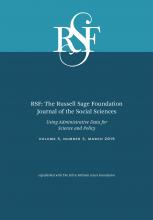Research Article
Open Access
Using Administrative Data for Social Science and Policy
Andrew M. Penner, Kenneth A. Dodge
RSF: The Russell Sage Foundation Journal of the Social Sciences March 2019, 5 (3) 1-18; DOI: https://doi.org/10.7758/RSF.2019.5.3.01
Andrew M. Penner
aprofessor of sociology at the University of California, Irvine
Kenneth A. Dodge
bPritzker Professor of Early Learning Policy Studies and professor of psychology and neuroscience at Duke University

REFERENCES
- ↵
- Abendroth, Anja-Kristin,
- Silvia Melzer,
- Alexandra Kalev, and
- Donald Tomaskovic-Devey
- ↵
- Abowd, John M.,
- John Haltiwanger, and
- Julia Lane
- ↵
- Aizer, Anna,
- Janet Currie,
- Peter Simon, and
- Patrick Vivier
- ↵
- ↵
- Ananat, Elizabeth O.,
- Anna Gassman-Pines,
- Dania V. Francis, and
- Christina M. Gibson-Davis
- ↵
- Anderson, Margo, and
- William Seltzer
- ↵
- ↵
- Bailey, Drew,
- Greg J. Duncan,
- Candice L. Odgers, and
- Winnie Yu
- ↵
- Blau, Peter, and
- Otis Dudley Duncan
- ↵
- Brummet, Quentin, and
- Emily Penner
- ↵
- Campbell, Frances,
- Gabriella Conti,
- James J. Heckman,
- Seong Hyeok Moon,
- Rodrigo Pinto,
- Elizabeth Pungello, and
- Yi Pan
- Candelaria, Christopher A
- ↵
- Chetty, Raj,
- John N. Friedman,
- Nathaniel Hilger,
- Emmanuel Saez,
- Diane Whitmore Schanzenbach, and
- Danny Yagan
- ↵
- ↵
- ↵
- ↵
- ↵
- Dodge, Kenneth A
- ↵
- ↵
- ↵
- Domina, Thurston,
- Andrew McEachin,
- Paul Hanselman,
- Priyanka Agarwal,
- NaYoung Hwang, and
- Ryan Lewis
- ↵
- Drabiak-Syed, Katherine
- ↵
- Fabelo, Tony,
- Michael D. Thompson,
- Martha Plotkin,
- Dottie Carmichael,
- Miner P. Marchbanks, and
- Eric A. Booth
- ↵
- Fernandez, Roberto M., and
- Santiago Campero
- ↵
- ↵
- Fernandez, Roberto M., and
- Jason Greenberg
- ↵
- Fernandez-Mateo, Isabel, and
- Roberto M. Fernandez
- ↵
- Finucane, Mariel McKenzie,
- Ignacio Martinez, and
- Scott Cody
- ↵
- Ganzeboom, Harry B. G.,
- Donald J. Treiman, and
- Wout C. Ultee
- ↵
- Godechot, Olivier
- ↵
- ↵
- Grusky, David B.,
- Michael Hout,
- Timothy M. Smeeding, and
- C. Matthew Snipp
- Hällsten, Martin
- ↵
- Holbein, John B
- ↵
- Howard, Lanikque,
- Lisa Klein Vogel,
- Maria Cancian, and
- Jennifer L. Noyes
- Ioannidis, John P. A
- ↵
- Kessler-Harris, Alice
- ↵
- Kim, ChangHwan, and
- Christopher R. Tamborini
- ↵
- King, Joseph,
- Andrew M. Penner,
- Nina Bandelj, and
- Aleksandra Kanjuo-Mrčela
- ↵
- ↵
- Li, Danielle
- ↵
- Liebler, Carolyn A.,
- Renuka Bhaskar, and
- Sonya R. Porter
- ↵
- ↵
- Meghir, Costas,
- Mårten Palme, and
- Marieke Schnabel
- Miller, Portia,
- Elizabeth Votruba-Drzal, and
- Rebekah Levine Coley
- ↵
- Mills, Jonathan N., and
- Patrick J. Wolf
- ↵
- Mueller, Anna S.,
- Tania M. Jenkins,
- Melissa Osborne,
- Arjun Dayal,
- Daniel M. O’Connor, and
- Vineet M. Arora
- Murray, Brittany,
- Thurston Domina,
- Linda Renzulli, and
- Rebecca Boylan
- ↵
- Open Science Collaboration
- Park, Hyunjoon
- ↵
- Penner, Emily K.,
- Jane Rochmes,
- Jing Liu,
- Sabrina Solanki, and
- Susanna Loeb
- ↵
- Persico, Claudia,
- David Figlio, and
- Jeffrey Roth
- ↵
- ↵
- Poulton, Richie,
- Avshalom Caspi,
- Barry J. Milne,
- W. Murray Thomson,
- Alan Taylor,
- Malcolm R. Sears, and
- Terrie E. Moffitt
- ↵
- Rafalow, Matthew H.,
- Cynthia Feliciano, and
- Belinda Robnett
- ↵
- ↵
- Song, Xi, and
- Cameron D. Campbell
- ↵
- Sun, Min,
- Emily K. Penner, and
- Susanna Loeb
- ↵
- Temby, Owen F., and
- Ken R. Smith
- ↵
- Tomaskovic-Devey, Donald
- U.S. Census Bureau
- ↵
- ↵
- ↵
- Wynn, John D.,
- Daniel A. Reyes, and
- Willard E. Caldwell
- ↵
In this issue
Using Administrative Data for Social Science and Policy
Andrew M. Penner, Kenneth A. Dodge
RSF: The Russell Sage Foundation Journal of the Social Sciences Mar 2019, 5 (3) 1-18; DOI: 10.7758/RSF.2019.5.3.01
Jump to section
Related Articles
- No related articles found.
Cited By...
- No citing articles found.





